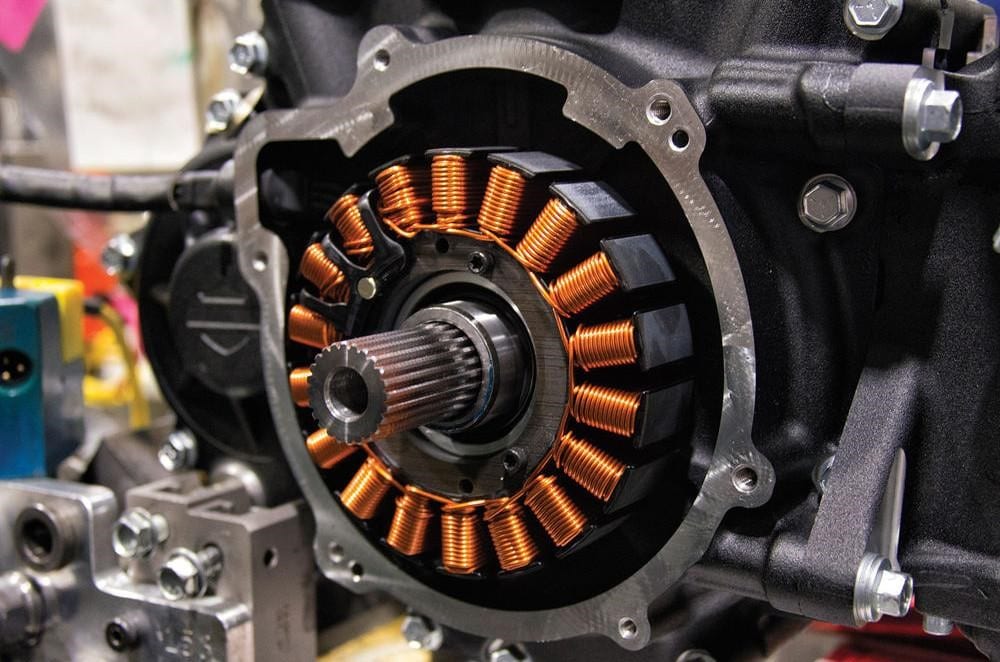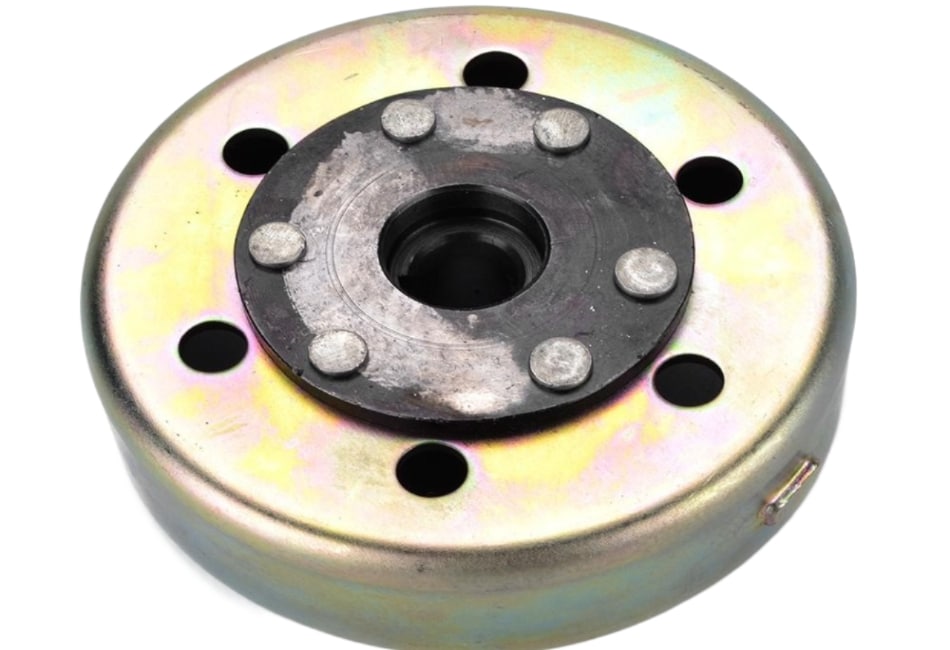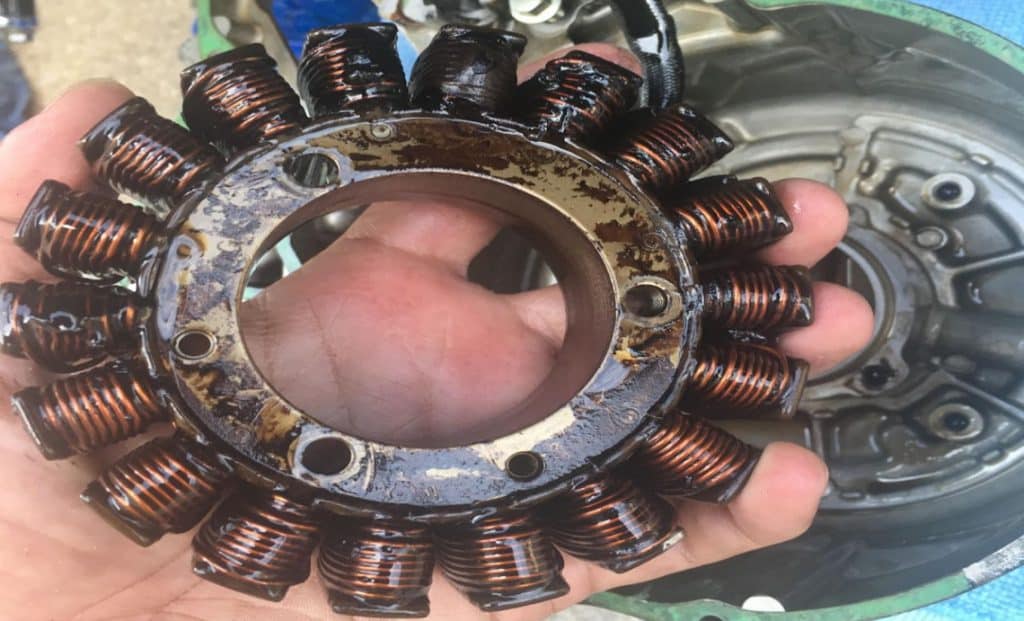Motorcycles have alternators whose primary function is to generate power for all electrical appliances while keeping the battery charged during operation. It’s part of the motorcycle charging system, which takes over from the battery as soon as the engine starts up and revs at normal idle speed.
The battery supplies the initial power to boot up the electronic controls like ECUs, fuel pump, lights, displays and most importantly the starter motor, which turns over the engine to crank it. This draws a huge amount of power from the battery, which it needs to top up after each cold start, and that is where the alternator comes in.
In Summary, Here Are the Different Types of Motorcycle Alternators and Their Characteristics
| Alternator Type /Characteristic | Permanent Magnet | Brush-Type | Brushless |
|---|---|---|---|
| Construction | Uses fixed magnetic field | Uses brushes and slip rings | Uses electromagnetic commutation |
| Efficiency | High | Low | High |
| Low RPM Output | High | Varies with design | High |
| Reliability and Durability | Very reliable with fewer moving parts | Requires regular maintenance for brushes and slip rings | More reliable than brush-type alternators |
| Power Output | Smooth output but may drop with an increase in temperature | Stable but may fluctuate if brushes are worn out | Stable |
| Cost | Cheapest | Low cost | Expensive and may require specialized controllers |
| Maximum Power | 300-500 watts | 200-400 watts | 500-1,000 watts |
Where Are Motorcycle Alternators Mounted and How Do They Work?

Motorcycle alternators are less obvious than their car counterparts because most motorcycles, except for large cruisers and touring bikes like the Honda Goldwing, don’t have the space to fit a one-piece automotive-style alternator. Incidentally, these bikes have an insatiable appetite for power with a horde of electronic accessories, which require a more powerful energy source
Every other motorcycle has a three-piece alternator consisting of a rotor, stator, and regulator/rectifier. These components make up the charging system, despite being mounted separately due to space limitations.
All Motorcycle Alternators Work Pretty Much the Same Way
An alternator is an electro-mechanical device that converts engine rotations (mechanical energy) into electrical energy (in watts). The working principle of these machines is guided by Faraday’s law, which states that when a conductor is placed in a varying electromagnetic field, an electromotive force (emf) is produced and if the conductor is a closed loop, a current is induced.
Put simply, if a coil of conducting wire is moved relative to a nearby magnet, electricity is produced in the wire whose voltage and current is proportional to the rate of change of the magnetic field (the speed of rotation for an alternator). This means higher revs produce more power in a motorcycle charging system.
Rotor

The rotor is essentially the part of the alternator that rotates with the crankshaft on which it’s mounted. It is the magnet half of Faraday’s law and could use permanent magnets or an electromagnet (uses a small current from the battery to set up a magnetic field).
In the latter types, the excitation current (providing initial magnetism) may be delivered to the rotor with physical carbon brush contacts or using magnetism, leading to three types of alternators.
Brush-Type, Brushless and Permanent Magnet Motorcycle Alternators
Brush types suffer heavy wear at the brushes and may be inefficient as friction eats away at the brushes. In contrast, brushless motors have significantly less moving parts using magnetic fields to transfer the energy without physical contact. They are more durable and efficient as a result although much more expensive.
A third type of motorcycle alternator uses permanent magnets in its rotor and doesn’t need an excitation current to start generating power as magnetism is always present by nature.
Side Note: In some motorcycle engines, the magnetic rotor also supplements the crankshaft, flywheel while in others it forms part of the flywheel. When this is the case, the alternator assembly may be called a flywheel magneto.
Stator

The stator is the part that contains the coils of wire in which the induced (generated) current flows. It’s typically made of laminated soft iron poles on which thin copper wires are wound and remains stationary.
Rather than one giant coil, there are often several coils, usually up to a dozen, each wound on a pole. It doesn’t matter whether the magnetic rotor revolves on the outside or inside of the stator; as long as there is relative motion between the two, electricity is generated. And because the magnets have a north and south polarity, the current induced in the stator coils repeatedly changes direction as they revolve.
This leads us to the third and final piece of the alternator puzzle…
Motorcycle Regulator/Rectifier

Yes, it’s that simple, a rotor with varying magnetic field rotates with the engine near a stationary (stator) coil and, bam, you have juice! One itty bitty issue though, the resulting voltage is of alternating current (AC), which is not compatible with the bike’s 12V DC system. And so, we feed it into the regulator/rectifier to convert it to direct current (DC).
Each motorcycle power regulator is designed to limit the voltage in the system within acceptable limits typically 13.8-14.5V. Total power output of a motorcycle alternator is 300W to 500W and may vary according to the requirements of each design. Regulators can be mechanical, shunt (parallel) or series regulators.
Mechanical regulators have physical contacts that open and close to control the voltage injected to the system. Shunt and series regulators are more modern and use transistors and diodes, respectively, to achieve the same goal.
4 Common Problems with Motorcycle Alternators

Motorcycle alternators face many hardships, not the least of which is being tucked away in the engine crankcase, where they fade into oblivion until they finally snap! And when they do, signs could include a dead battery, dim lights that brighten with higher revs, weak spark or no spark at all, difficulty starting the bike, and lagging acceleration.
Despite their small sizing due to space constraints, they have to deal with angrier engines, revving often, revving upwards of 10,000 RPM, and power everything as the battery is only good for starting. That is really immense pressure, but these systems, as you would expect, really push the limits before tapping out.
Here are four common issues a mechanic can help you fix when your motorcycle alternators stalls:
1. Worn Brushes
Brush-type alternators utilize carbon brushes to transfer energy between the rotor and stator through constant rubbing, which leads to wear and tear. As time goes by, the brushes become depleted, resulting in sparking and power loss at the junction, ultimately resulting in failure.
2. Belt Tension for Motor-Vehicle-Style Alternators
A few motorcycles use external alternators like those you find in cars, and they rely on a belt drive to transfer the engine’s rotation to the alternator’s rotor. If the belt is loose, slippage occurs, leading to reduced power output. On the other hand, if the belt is too tight or worn out, it could cause damage to the bearings, eventually leading to alternator failure.
This brings us to the next common issue…
3. Bearing Failure
Again, external alternators are particularly prone to this issue because their bearings may not receive enough lubrication. When bearings fail, it doesn’t spin as fast, generating less power while producing excess heat and a whining noise.
4. Overheating
Overheating cuts across all alternators. Because of the high speed of operation and high power demands of the motorcycle, alternators generate a lot of heat, which can melt the insulation on the windings. Cooling system failure or inefficiency could cause a gradual build-up of heat.
Bigger alternators under heavier loads tend to produce more heat, which is why they may be placed outside the engine case with a dedicated cooling fan.
My Final Thoughts on Do Motorcycles Have Alternators?

Alternators can be quite technical, and I wouldn’t recommend tampering with them unless you are a qualified professional with a good understanding of how they work. Further, it’s not feasible that you try and change out one type of alternator for another in your motorcycle as this could burn fuses and other problems.
However, maintaining a healthy motorcycle electrical system with clean and dry sockets, proper rated fuses, a healthy regulator and battery with clean terminals are a good place to start for a positive trickle-down effect on your alternator’s lifespan.
Also, avoid overloading the alternator with too many aftermarket electrical accessories, like auxiliary lights as well as heated grips and seats, which may not be accounted for in the original design.

I've diligently categorized my motorcycle gear recommendations into all available categories, with the aim of providing you with a comprehensive analysis that showcases the absolute best options for all your needs. These items are the culmination of in-depth research, extensive testing, and personal use throughout my vast experience of 50+ years in the world of motorcycling. Besides being a passionate rider, I've held leadership positions and offered consultancy services to reputable companies in over 25 countries. To See Top Picks and the Best Prices & Places to Buy: Click Here! |
Information for this article was partially sourced and researched from the following authoritative government, educational, corporate, and non-profit organizations:













